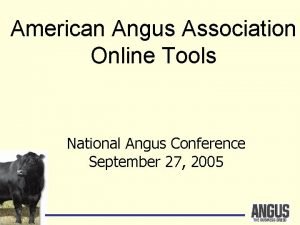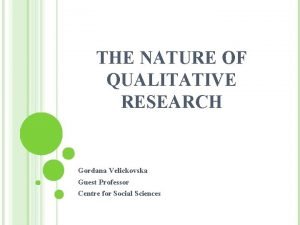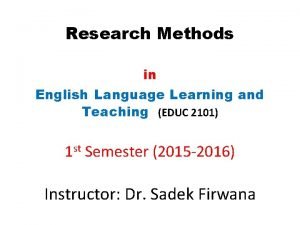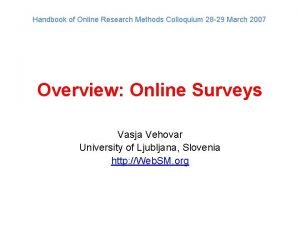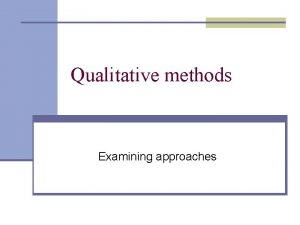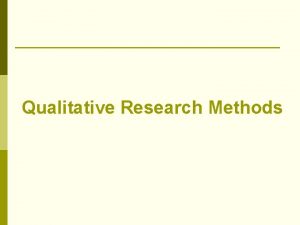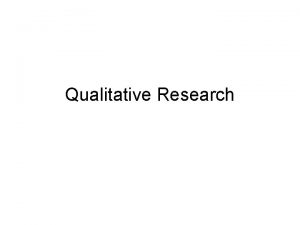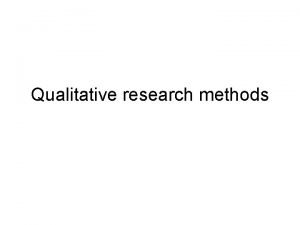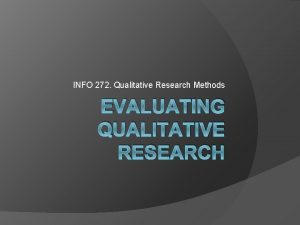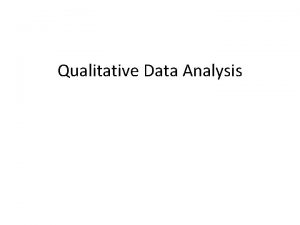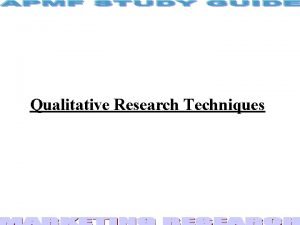Qualitative Research Approaches Research Methods Module Assoc Prof





















- Slides: 21

Qualitative Research Approaches Research Methods Module Assoc Prof. Chiwoza R Bandawe

MALAWI DHS 2010 Maternal Mortality 675/100, 000 Under 5 Mortality 112/000 Infant Mortality 66/000 Age of first sexual intercourse Female: 17. 3, Male 18. 6 Literacy rate: Male 81%, Female 67. 6% Malnutrition stunted 47%

“Through qualitative research we can explore a wide array of dimensions of the social world, including the texture and weave of everyday life, the understandings, experiences and imaginings of our research participants, the ways that social processes, institutions, discourses or relationships work, and the significance of the meanings that they generate” Jennifer Mason

Qualitative research approaches: “Celebrate richness, depth, nuance, context, multidimensionality and complexity” of the social world Can help us see “how things work in particular contexts” Have grown out of a wide range of disciplinary and intellectual traditions

Qualitative research theories Assumes a psychological reality and that methods are a way of getting to this reality Wide range of theories. It is a theory method Discourse analysis: Language a reflection of inner reality. Language constructs identity. Language centred, what it does, how it operates

Quantitative Research methods Repeatability Facts. How many, how long? , how much? Predetermined categories of analysis Structured, based on analysis Compare groups and focus on variables Weakness: Not all social problems addressed

What are qualitative research approaches? Based on interpretation: Asks why Holistic understanding of behaviour Based on language Captures the perspective of the population in their world view experience Patterns of themes said, not said Context sensitive

Challenges of qualitative research Systematically and rigorously conducted Strategically conducted, flexible, contextual Active reflexivity (researcher is a player) Produce explanations or arguments. Be generalisable and show wider resonance

Qualitative Tenets • There are “multiple realities” not just one objective reality. • Truth is in informant’s perspective, not the assessors. • Assessment “emerges” from data, rather than being determined ahead of time.

Which is better Qualitative or Quantitative research? Complimentary: Qualitative can help develop quantitative instrument Quantitative findings embellish qualitative findings Qualitative data explains quantitative findings

Qualitative vs. Quantitative The different enquiry approaches demand different knowledge (Stevenson & Roger, 1995). Synergetic effect: “The outcome of the two used together is greater than the effects of either used separately” Steckler et al. (1992).

Qualitative Approaches Ethnography Grounded theory Phenomenology Case studies

Ethnography Concerned with experience as it is lived, felt or undergone Participates in people’s daily lives Purpose is to uncover social, cultural, or normative patterns Participants are the experts Is essentially a cultural description

Ethnography Behavior occurs in a context and ethnography takes that context into account Assessors must become immersed in a particular situation in order to describe and interpret people’s actions Involves observation, interviews, construction of working hypothesis and action

Ethnography uncovers… Understandings (e. g. , beliefs, perceptions, knowledge) which participants share about their situation Routine methods (e. g. , social rules, expectations, patterns, roles) by which their situation is structured The legitimizations by which participants justify the normality and unquestioned character of their situation Motives and interests (e. g. , purposes, goals, plans) through which participants interpret their situation

Ethnography strengths & weaknesses Strengths Uses multiple methods of collecting data Can provide rich data Weaknesses Assessor is assessment tool, subject to subjectiveness Time consuming for data collection Time consuming for analysis May be difficult to gain access to group

Case studies Single group e. g students Single village Single family Individual e. g. Eugene de Kock

Qualitative Methodologies Interviews Focus Group Discussions Participant Observation Direct Observation Diary Methods Role Play and Simulation

Interviewing Informal interviewing Unstructured interviewing Semi-structured interviews Fully structured/formal Probing: Silent, Echo, Uh-hum, Probing by leading.

Focus Group Discussions Quick effective, homogenous group Focussed on specific topic 6 -12 persons, 45 -90 minutes Set agreed rules Observe group dynamics Record and transcribe

Participant observation Ethnographic approach Structured to unstructured continuum Unobtrusive note taking Context, participants, observer, actions, interpretation, alternative interpretation, feelings Why observe, who observe, what used?
 Common lisp sort
Common lisp sort American angus association login
American angus association login Qualitative analysis political science
Qualitative analysis political science Qualitative research research design
Qualitative research research design Quota sampling
Quota sampling Visual methods in qualitative research
Visual methods in qualitative research Qualitative research methods
Qualitative research methods What is the sample size in qualitative research?
What is the sample size in qualitative research? Qualitative research methods
Qualitative research methods Methodology
Methodology Qualitative research methods
Qualitative research methods Ap psychology module 2 review
Ap psychology module 2 review Direct instruction
Direct instruction Appendices research example
Appendices research example Chapter 3 parts
Chapter 3 parts Importance of qualitative research
Importance of qualitative research Characteristics of qualitative approach
Characteristics of qualitative approach Integrating qualitative and quantitative methods
Integrating qualitative and quantitative methods Qualitative forecasting methods
Qualitative forecasting methods C device module module 1
C device module module 1 Direct wax pattern technique
Direct wax pattern technique Marketing research approaches to demand estimation
Marketing research approaches to demand estimation

